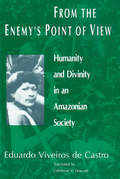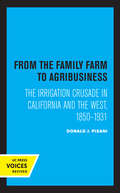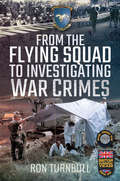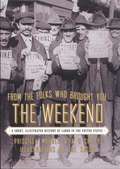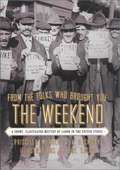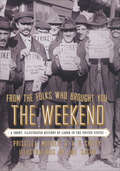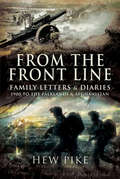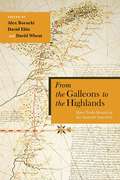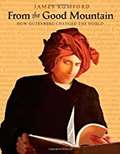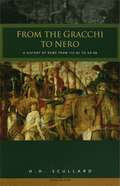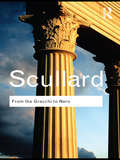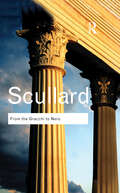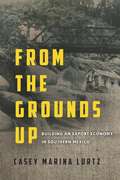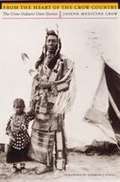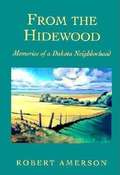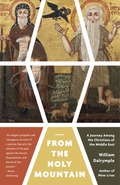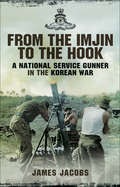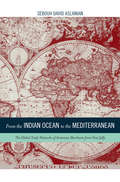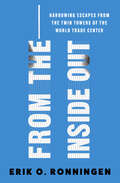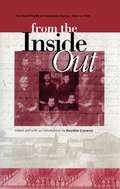- Table View
- List View
From the Edge: Australia's Lost Histories
by Mark McKennaIn March 1797, five British sailors and 12 Bengali seamen struggled ashore after their longboat broke apart in a storm. Their fellow-survivors from the wreck of the Sydney Cove were stranded more than 500 kilometres southeast in Bass Strait. To rescue their mates and to save themselves the 19 men must walk 700 kilometres north to Sydney.That remarkable walk is a story of endurance but also of unexpected Aboriginal help.From the Edge: Australia's Lost Histories recounts four such extraordinary and largely forgotten stories: the walk of shipwreck survivors; the founding of a 'new Singapore' in western Arnhem Land in the 1840s; Australia's largest industrial development project nestled amongst outstanding Indigenous rock art in the Pilbara; and the ever-changing story of James Cook's time in Cooktown in 1770.This new telling of the central drama of Australian history ;the encounter between Aboriginal and non-Aboriginal Australians, may hold the key to understanding this land and its people.
From the Enemy's Point of View: Humanity and Divinity in an Amazonian Society
by Eduardo Viveiros de CastroThe Araweté are one of the few Amazonian peoples who have maintained their cultural integrity in the face of the destructive forces of European imperialism. In this landmark study, anthropologist Eduardo Viveiros de Castro explains this phenomenon in terms of Araweté social cosmology and ritual order. His analysis of the social and religious life of the Araweté—a Tupi-Guarani people of Eastern Amazonia—focuses on their concepts of personhood, death, and divinity. Building upon ethnographic description and interpretation, Viveiros de Castro addresses the central aspect of the Arawete's concept of divinity—consumption—showing how its cannibalistic expression differs radically from traditional representations of other Amazonian societies. He situates the Araweté in contemporary anthropology as a people whose vision of the world is complex, tragic, and dynamic, and whose society commands our attention for its extraordinary openness to exteriority and transformation. For the Araweté the person is always in transition, an outlook expressed in the mythology of their gods, whose cannibalistic ways they imitate. From the Enemy's Point of View argues that current concepts of society as a discrete, bounded entity which maintains a difference between "interior" and "exterior" are wholly inappropriate in this and in many other Amazonian societies.
From the Family Farm to Agribusiness: The Irrigation Crusade in California and the West, 1850–1931
by Donald J. PisaniThis title is part of UC Press's Voices Revived program, which commemorates University of California Press’s mission to seek out and cultivate the brightest minds and give them voice, reach, and impact. Drawing on a backlist dating to 1893, Voices Revived makes high-quality, peer-reviewed scholarship accessible once again using print-on-demand technology. This title was originally published in 1984.
From the Flying Squad to Investigating War Crimes
by Ron Turnbull“Looks at more recent genocide through the eyes of a British detective who spent time investigating Bosnian war crimes . . . fascinating insight.” —FiretrenchFor over ten years he was first detective on the scene when a murder was committed in south London. In the confusion and horror of the crime scene he identified the forensic clues that would later be needed to convict the killer in the calm and measured atmosphere of the Old Bailey; calling out the necessary experts from pathologists to ballistics specialists; protecting the scene against contamination. One slip and a case would crumble; one moment of inspiration and the Yard would have its man. He was the natural choice when the UN were looking for an experienced detective to create a trail of evidence linking the mass graves of Bosnia to the people who ordered the worst war crimes seen in Europe since the Second World War. From the Flying Squad to Investigating War Crimes tells of the rise of forensic evidence against the true story backdrop of a detective who has spent a career at the front line in the war against murder—the ultimate crime. It traces the development of forensic science and techniques from the days of the fingerprint to the battery of tests now available to homicide investigators. It is told in the no nonsense style of a pioneer cop who has seen the worst that human beings can do to each other.“The extraordinary autobiography of an extraordinary man who gathered evidence against the most heinous criminals.” —Books Monthly
From the Folks Who Brought You the Weekend
by Joe Sacco Priscilla Murolo A. B. ChittyHailed in a starred Publishers Weekly review as a work of "impressive even-handedness and analytic acuity . . . that gracefully handles a broad range of subject matter," From the Folks Who Brought You the Weekend is the first comprehensive look at American history through the prism of working people. From indentured servants and slaves in the seventeenth-century Chesapeake to high-tech workers in contemporary Silicon Valley, the book "[puts] a human face on the people, places, events, and social conditions that have shaped the evolution of organized labor" (Library Journal).From the Folks Who Brought You the Weekend also "thoroughly includes the contributions of women, Native Americans, African Americans, immigrants, and minorities, and considers events often ignored in other histories," writes Booklist, which adds that "thirty pages of stirring drawings by 'comic journalist' Joe Sacco add an unusual dimension to the book."
From the Folks Who Brought You the Weekend: A Short, Illustrated History of Labor in the United States
by Joe Sacco Priscilla Murolo A. B. ChittyHailed in a starred "Publishers Weekly" review as a work of "impressive even-handedness and analytic acuity . . . that gracefully handles a broad range of subject matter, " This is the first comprehensive look at American history through the prism of working people.
From the Folks Who Brought You the Weekend: An Illustrated History of Labor in the United States
by Priscilla Murolo A.B. ChittyNewly updated: &“An enjoyable introduction to American working-class history.&” —The American Prospect Praised for its &“impressive even-handedness&”, From the Folks Who Brought You the Weekend has set the standard for viewing American history through the prism of working people (Publishers Weekly, starred review). From indentured servants and slaves in seventeenth-century Chesapeake to high-tech workers in contemporary Silicon Valley, the book &“[puts] a human face on the people, places, events, and social conditions that have shaped the evolution of organized labor&”, enlivened by illustrations from the celebrated comics journalist Joe Sacco (Library Journal). Now, the authors have added a wealth of fresh analysis of labor&’s role in American life, with new material on sex workers, disability issues, labor&’s relation to the global justice movement and the immigrants&’ rights movement, the 2005 split in the AFL-CIO and the movement civil wars that followed, and the crucial emergence of worker centers and their relationships to unions. With two entirely new chapters—one on global developments such as offshoring and a second on the 2016 election and unions&’ relationships to Trump—this is an &“extraordinarily fine addition to U.S. history [that] could become an evergreen . . . comparable to Howard Zinn&’s award-winning A People&’s History of the United States&” (Publishers Weekly). &“A marvelously informed, carefully crafted, far-ranging history of working people.&” —Noam Chomsky
From the Frontline: Family Letters and Diaries: 1900 to the Falklands and Afghanistan
by Hew PikeFrom the Frontline is an extraordinary record of a familys military service over the last 100 years. Thanks to careful editing, each individual tells his story through letters and diaries which capture the military scene and reflect family ties that bind them all closely. The eight family members served in South Africa, West Africa, Korea, Aden, the Falklands and Afghanistan as well as both World Wars. One lost his life and others were wounded. Two became generals, many were decorated. Their records may span a century when warfare changed greatly. Yet the tone of the letters remains surprisingly constant reflecting confidence in their fellows, a pride in service to Crown and Country, love of family and understatement of the dangers. Being thinking men, their views on the conduct of operations is sometimes critical as are their opinions of their leaders. This collection is highly unusual and totally enthralling.
From the Galleons to the Highlands: Slave Trade Routes in the Spanish Americas (Diálogos Series)
by Alex Borucki, David Eltis and David WheatThe essays in this book demonstrate the importance of transatlantic and intra-American slave trafficking in the development of colonial Spanish America, highlighting the Spanish colonies&’ previously underestimated significance within the broader history of the slave trade. Spanish America received African captives not only directly via the transatlantic slave trade but also from slave markets in the Portuguese, English, Dutch, French, and Danish Americas, ultimately absorbing more enslaved Africans than any other imperial jurisdiction in the Americas except Brazil. The contributors focus on the histories of slave trafficking to, within, and across highly diverse regions of Spanish America throughout the entire colonial period, with themes ranging from the earliest known transatlantic slaving voyages during the sixteenth century to the evolution of antislavery efforts within the Spanish empire. Students and scholars will find the comprehensive study and analysis in From the Galleons to the Highlands invaluable in examining the study of the slave trade to colonial Spanish America.Understanding Latin America demands dialogue, deep exploration, and frank discussion of key topics. Founded by Lyman L. Johnson in 1992 and edited since 2013 by Kris Lane, the Diálogos Series focuses on innovative scholarship in Latin American history and related fields. The series, the most successful of its type, includes specialist works accessible to a wide readership and a variety of thematic titles, all ideally suited for classroom adoption by university and college teachers.
From the Good Mountain: How Gutenberg Changed The World
by James RumfordWhat was made of rags and bones, soot and seeds? What took a mountain to make? <p><p> For the answer, travel back to the fifteenth century―to a time when books were made by hand and a man named Johannes Gutenberg invented a way to print books with movable type. <p> Written as a series of riddles and illustrated in the style of medieval manuscripts by an award-winning author and artist, From the Good Mountain will intrigue readers of all ages. On every page there is something surprising to learn about how the very thing you are holding in your hands came to be.
From the Gracchi to Nero: A History of Rome 133 BC to AD 68
by H. H. ScullardScullard's clear and comprehensive narrative covers the period from 133 BC to 69 AD, exploring the decline and fall of the Republic, and the establishment of the Pax Romana under the early Principate. More than forty years after its first publication this masterful survey remains the standard textbook on the central period of Roman history.
From the Gracchi to Nero: A History of Rome 133 BC to AD 68
by H. H. ScullardFrom the Gracchi to Nero is an outstanding history of the Roman world from 133 BC to 68 AD. Fifty years since publication it is widely hailed as the classic survey of the period, going through many revised and updated editions until H.H. Scullard’s death. It explores the decline and fall of the Roman Republic and the establishment of the Pax Romana under the early Principate. In superbly clear style, Scullard brings vividly to life the Gracchi’s attempts at reform, the rise and fall of Marius and Sulla, Pompey and Caesar, society and culture in the late Roman Republic, the Augustan Principate, Tiberius and Gaius, Claudius and Nero, and economic and social life in the early Empire.
From the Gracchi to Nero: A History of Rome 133 BC to AD 68 (Routledge Classics)
by H.H. ScullardFrom the Gracchi to Nero is an outstanding history of the Roman world from 133 BC to 68 AD. Fifty years since publication it is widely hailed as the classic survey of the period, going through many revised and updated editions until H.H. Scullard’s death. It explores the decline and fall of the Roman Republic and the establishment of the Pax Romana under the early Principate. In superbly clear style, Scullard brings vividly to life the Gracchi’s attempts at reform, the rise and fall of Marius and Sulla, Pompey and Caesar, society and culture in the late Roman Republic, the Augustan Principate, Tiberius and Gaius, Claudius and Nero, and economic and social life in the early Empire.
From the Great Recession to the Covid-19 Pandemic: A Financial History of the United States 2010-2020 (Financial History of the United States)
by Jerry W. MarkhamThis volume narrates the financial history of the United States during a period of great upheaval in the early part of the twenty-first century. It is divided into three chronological sections: the first section describes the recovery of financial markets after the Great Recession. It begins with an overview of the state of the economy at the start of the new decade, including some of the political storms affecting the economy and financial markets. It explores the uneven nature of the recovery and volatility in the Treasury during these years. The second section sets forth regulatory responses to the Financial Crisis of 2008, including the massive fines imposed on large banks by a swarm of regulators. It examines the ‘too big to jail’ prosecution model, cases involving Libor and foreign exchange manipulation, and the impact of rogue traders. It also looks as developments in payment systems, and the rise of crowdfunding as a source of capital, and high-frequency trading. And the third section describes the rules adopted under the Dodd-Frank Act of 2010 that broadly affected financial markets. It also recounts the Trump trade wars and ends with an account of the financial and economic turmoil that occurred during the Covid-19 pandemic in 2020. The volume will be essential addition to academic and public libraries with readers drawn from business schools, departments of economics and finance, and historians.
From the Ground Up: Stories from the men and women who built, serviced and flew aircraft in WWII (W&N Military)
by Edward Smithies'Fascinating ... this collection illuminates corners of the wartime world ... it provides a valuable and often entertaining window' GUARDIAN'The horrors have not been suppressed. Everyone who speaks was very young then. You sense their wonder that they did the things they recall' INDEPENDENT ON SUNDAYWhen we remember the Second World War in the air, we think of fighter pilots and bomber crews. But what was it like for the men and women working as ground crew and in the aircraft factories who also played a crucial role in defeating Hitler? What was it like making history? What sense did these individuals have of what they were doing, either at the time or later? Did they feel they were caught up in the tide of great events? Or were they simply doing their demanding and often dangerous duty?Originally published as ACES, ERKS AND BACKROOM BOYS
From the Ground Up: The Story of “Brother Van”, Montana Pioneer Minister, 1848-1919
by Robert W. LindThis book, which was first published in 1961, is a biography of Rev. William Wesley Van Orsdel (1848-1919), known as “Brother Van”, a Methodist circuit rider in Montana who made a significant contribution to the spread of Methodism in Montana and the early development of the state’s public institutions. Throughout his career, Brother Van founded churches, universities, and hospitals; he converted and ministered to homesteaders, miners, and Native Americans; he worked with the elites and the poor, the famous and the forgotten in a career that spanned nearly 50 years.“To paint a word picture of the pioneer preacher and the pioneer territory which captures the real feeling which Brother Van had for Montana and which Montana had for Brother Van is almost impossible. But Bob Lind, a part of the Church which Brother Van helped to establish, has come closer than any writer to date.“Lind’s picture of Brother Van and his times is reliably accurate, though it was no easy task to detach fact from fiction in giving account of a man about whom stories grew like grass on the Montana prairie. He found in Brother Van’s life so much adventure and color that he only needed to tell the story as it was.“When you finish reading this book you will have met the best of the early frontier in the Rocky Mountain west. You will follow a man who made a pulpit for preaching the Good News out of the freighter’s or cowboy’s camp, the cabin or the ranch home, the Indian tepee, the barroom or the street corner. And you will see that to all of his congregations, formal or informal, he always gave his best in word and song.”—George A. Harper, Foreword
From the Grounds Up: Building an Export Economy in Southern Mexico
by Casey Marina LurtzIn the late nineteenth century, Latin American exports boomed. From Chihuahua to Patagonia, producers sent industrial fibers, tropical fruits, and staple goods across oceans to satisfy the ever-increasing demand from foreign markets. In southern Mexico's Soconusco district, the coffee trade would transform rural life. A regional history of the Soconusco as well as a study in commodity capitalism, From the Grounds Up places indigenous and mestizo villagers, migrant workers, and local politicians at the center of our understanding of the export boom. An isolated, impoverished backwater for most of the nineteenth century, by 1920, the Soconusco had transformed into a small but vibrant node in the web of global commerce. Alongside plantation owners and foreign investors, a dense but little-explored web of small-time producers, shopowners, and laborers played key roles in the rapid expansion of export production. Their deep engagement with rural development challenges the standard top-down narrative of market integration led by economic elites allied with a strong state. Here, Casey Marina Lurtz argues that the export boom owed its success to a diverse body of players whose choices had profound impacts on Latin America's export-driven economy during the first era of globalization.
From the Heart of the Crow Country: The Crow Indians' Own Stories
by Herman J. Viola Joseph Medicine CrowThe world of the Crow Indians comes to life in this extraordinary collection of stories from respected elder and famed storyteller Joseph Medicine Crow. Raised by traditional grandparents, who remembered life before the reservation days, MedicineøCrow as a child would listen to stories that his grandfather and other elders told during sweat baths. He also learned about the Indian wars of earlier years from White Man Runs Him, one of Custer's Crow scouts. Medicine Crow became a passionate collector of stories and information about Crow life and history. This volume is a fascinating and informative collection of legends, humorous tales, history, and detailed accounts of life and culture, all told from Crow points of view.
From the Hidewood: Memories of a Dakota Neighborhood
by Robert C. AmersonIn 21 interwoven stories, author Robert Amerson re-creates life on his family's 160-acre farm in the remote Hidewood Hills of eastern South Dakota from 1934 to 1942. In exquisite detail, he portrays a particular moment in time with a power that could help many readers better understand their own pasts.
From the Holy Mountain
by William DalrympleIn the spring of A.D. 587, John Moschos and his pupil Sophronius the Sophist embarked on a remarkable expedition across the entire Byzantine world, traveling from the shores of Bosphorus to the sand dunes of Egypt. Using Moschos's writings as his guide and inspiration, the acclaimed travel writer William Dalrymple retraces the footsteps of these two monks, providing along the way a moving elegy to the slowly dying civilization of Eastern Christianity and to the people who are struggling to keep its flame alive. The result is Dalrymple's unsurpassed masterpiece: a beautifully written travelogue, at once rich and scholarly, moving and courageous, overflowing with vivid characters and hugely topical insights into the history, spirituality and the fractured politics of the Middle East.
From the House to the Streets: The Cuban Woman's Movement for Legal Reform, 1898-1940
by K. Lynn StonerFrom the House to the Streets is the first study on feminists and the feminist movement in Cuba between 1902 and 1940. In the four decades following its independence form Spain in 1898, Cuba adopted the most progressive legislation for women in the western hemisphere. K. Lynn Stoner explains how a small group of women and men helped to shape broad legal reforms: she describes their campaigns, the version of feminism they adopted with all its contradictions, and contrasts it to the model of feminism North Americans were transporting to Cuba. Stoner draws on rich primary sources--texts, personal letters, journal essays, radio broadcasts, memoirs from women's congresses--which allow these women to speak in their own voices. In reconstructing the mentalit of Cuban feminists, who came primarily from a privileged social status, Stoner shows how feminism drew from traditional notions of femininity and a rejection of gender equality to advance a cause that assumed women's expanded roles were necessary for social progress. She also examines the values of the progressive male politicians who supported feminists and worked to change Cuban laws.
From the Imjin to the Hook: A National Service Gunner in the Korean War
by James JacobsThe British Armys considerable contribution to The Korean War 1950 1953 was largely composed of conscripts or national servicemen. Plucked from civilian life on a lottery basis and given a short basic training, some like Jim Jacobs volunteered for overseas duty and suddenly found themselves in the thick of a war as intensive and dangerous as anything the Second World War had had to offer.As a member of 170 Independent Mortar Battery RA from March 1951 to June 1952 Jim was in the frontline at the famous Battle of the Imjin River. By great luck, he evaded capture and death unlike so many. He returned to the UK only to volunteer again for a second tour with 120 Light Battery from March 1953 to March 1954. During this period, he was in the thick of the action at the Third Battle of the Hook during May 1953.In this gripping memoir, Jim calmly and geographically recounts his experiences and emotions from joining the Army through training, the journeys by troopship and, most importantly, on active service in the atrocious and terrifying war fighting that went on in a very foreign place.
From the Indian Ocean to the Mediterranean: The Global Trade Networks of Armenian Merchants from New Julfa
by Sebouh David AslanianDrawing on a rich trove of documents, including correspondence not seen for 300 years, this study explores the emergence and growth of a remarkable global trade network operated by Armenian silk merchants from a small outpost in the Persian Empire. Based in New Julfa, Isfahan, in what is now Iran, these merchants operated a network of commercial settlements that stretched from London and Amsterdam to Manila and Acapulco. The New Julfan Armenians were the only Eurasian community that was able to operate simultaneously and successfully in all the major empires of the early modern world--both land-based Asian empires and the emerging sea-borne empires--astonishingly without the benefits of an imperial network and state that accompanied and facilitated European mercantile expansion during the same period. This book brings to light for the first time the trans-imperial cosmopolitan world of the New Julfans. Among other topics, it explores the effects of long distance trade on the organization of community life, the ethos of trust and cooperation that existed among merchants, and the importance of information networks and communication in the operation of early modern mercantile communities.
From the Inside Out: Harrowing Escapes from the Twin Towers of the World Trade Center
by Erik O. RonningenFifteen survivors of the September 11 attack on the World Trade Center share their dramatic stories of that fateful day. On September 11, 2001, tens of thousands in New York City awakened to a beautiful Tuesday morning. Just like any other day, they completed their morning routines and headed to work. For Erik Ronningen, that was his job with the Port Authority of New York and New Jersey at the World Trade Center. Ronningen had a big, career-changing meeting scheduled for 9 A.M. At 8:46 A.M., Erik was on the seventy-first floor of the North Tower when American Airlines Flight 11 struck the building. As acrid smoke filled the building, he made his way downstairs, hoping to get to the Security Command Center in the basement of the South Tower. However, he was unable to reach it and was the last person to exit the South Tower alive . . . In From the Inside Out, Ronningen shares the story of his harrowing escape, along with stories from fourteen other survivors. These gripping accounts chronicle individuals displaying courage and heroism when their ordinary day quickly became a fiery scramble for survival.
From the Inside Out: The Rural Worlds of Mennonite Diarists
by Royden LoewenHistorian Royden Loewen has brought together selections from diaries kept by 21 Mennonites in Canada between 1863 and 1929, some translated from German for the first time. By skillfully comparing and contrasting a wide cross-section of lives, Loewen shows how these diaries often turn the hidden contours of household and community "inside out." The writers featured were ordinary rural people: young women and grandmothers, rural preachers and landless householders. They include a teenaged boy who immigrated from Russia to Manitoba in 1875 as well as a successful merchant, a traveling evangelist, and a devout, conservative church elder. An elderly grandfather recounted the daily circuit of his children's homes, while 19-year-old Marie Schoeder wrote of her literary aspirations, her "secret hope" that some day she would "write things that have a real worth, things that are worth printing, and things that other folks would love to read and pay for." From the Inside Out also contrasts diaries from two distinct Mennonite communities in Canada. The Swiss-American Mennonites in Waterloo County, Ontario, faced rapid urbanization, while the Dutch-Russian Mennonites in southern Manitoba maintained their more rural environment. The diaries mirror their writers' preoccupations with work and weather, but they also reveal a communityís social structure and round of activities such as weddings, funerals, and worship services. In the process of diary-keeping, the writers sought to make sense of a dynamic and often unpredictable world. Reading what they chose to record is to learn much about their culture. Their writings provide glimpses of their lives, their collective mindset, and their history as a people.

